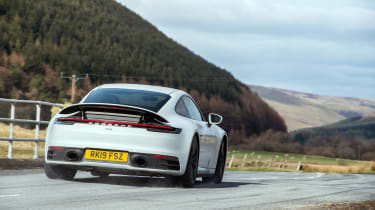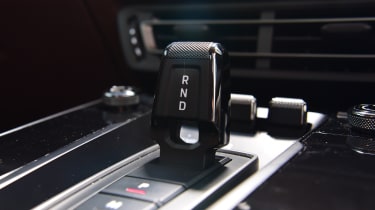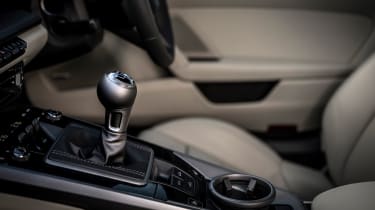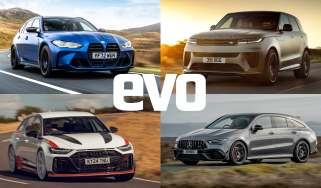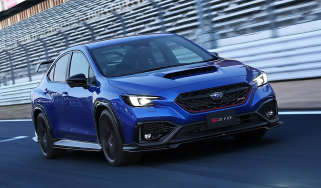Porsche 911 review - engine, gearbox and technical details
Engine range comprises a pair of turbocharged 3-litre flat-sixes, with either an eight-speed PDK or no-cost option seven-speed manual
The 911 is now available with the full range of powertrain options, with the Carrera models using a twin-turbocharged 2981cc flat-six petrol engine available in three states of tune. These can be connected to either an eight-speed dual-clutch transmission or optional six-speed manual, and with two or all-wheel drive.
Unlike the 911 Turbo, the Carrera engine uses two standard non-variable geometry turbochargers, and includes Porsche’s variable cam and valve timing. The compression ratio is 10.2:1 and all variants of this powertrain hit a 7500rpm red line.
The standard Carrera and new Carrera T use the lowest output of this engine, producing 380bhp at 6500rpm and 332lb ft of torque between 1950rpm and 5000rpm. These are restrained figures, particularly the torque, but neither feel tardy due to the extremely low point in the rev range that the peak is reached. It’s also worth noting that the low boost pressures make the engine incredibly responsive, helping the engine stay strong even with the six-speed manual’s much longer ratios.
The Carrera S is next up, lifting power to 444bhp, also reached at 6500rpm, with a more stout 391lb ft available over a marginally narrower plateau between 2300rpm and 5000rpm. These figures, for reference, are very similar to the output produced by the old 991 Carrera GTS (and comfortably above the 996 Turbo’s – how times have changed).
The Carrera GTS has the most generous power figures from the 3-litre unit without treading on the toes of the Turbo, with 473bhp generated, again at 6500rpm. Torque goes up again to 420lb ft, again generated between 2300rpm and 5000rpm. There are no hardware changes between the three engine variants – it’s all about the ECU.
Porsche’s high-torque eight-speed PDK dual-clutch transmission is standard across the range, but all models except for the base Carrera and Carrera 4s can be specified with a six-speed manual as a no-cost option. All-wheel drive is available with all three engine options, and utilises a part-time system that only engages the front wheels under certain conditions.
More reviews
Group tests
- Mercedes-AMG GT 63 v Porsche 911 Turbo S: all-wheel drive GTs go head-to-head
- Porsche 911 GT3 group test – 996 takes on 997
In-depth reviews
- Porsche 911 GT3 (996, 1999-2005) review – the purest GT3 of them all?
- Porsche 911 (992.1, 2018-2024) – the 911 of the digital age
Reviews
- Porsche 911 Carrera (992.2) 2025 review – is the most basic 911 the sweet-spot?
- Used Porsche 911 (997, 2004-2012): review, history, specs and buying guide
- Thornley Kelham Porsche 911 European RS restomod review – worth £650k?
- Porsche 911 reimagined by Singer Classic Turbo 2024 review – the most complete restomod?
- Porsche 911 GT3 (997, 2006 - 2011): the ultimate modern classic?
All 992s also feature petrol particulate filters in the exhaust system, helping them to meet Euro 6 emissions regulations, but elsewhere it’s business as usual: suspension is by MacPherson struts up front (except the GT3) with a multi-link rear axle, and the rack and pinion steering is electrically assisted. The wheel and tyre set-up is staggered: 19 and 20 inches on the Carrera, 20 and 21 on everything else.
In this generation of 911, the specific variant isn’t the only variable that can completely transform how a specific model drives, as the options list is full of chassis hardware upgrades. All models are available with a PASM Sport option that pairs the standard adaptive dampers with a 10mm drop in ride height. Porsche’s Dynamic Chassis Control is an expensive option that cancels out lateral body roll through the use of active anti-roll bars. This is only available with the also optional rear-wheel-steering system, making it a £3865 option.
There’s also a sports exhaust system on the options list for the base Carrera and Carrera S that swap out their specific exhaust tips (oblong for the Carrera, round quads for the S) for a more generic set of oval outlets. Porsche’s PCCB ceramic brake option is also available for a touch over £6300. We generally have preferred 911s specified without most of the chassis upgrades, as it gives the 911 a more natural feel. There are caveats, as not all options are available on all models, but you’d be hard-pressed to feel reined in by the sheer amount of variations.
The 992’s structure is more aluminium-intensive than ever before, but retains a mixed-metal construction. Only 30 per cent of the shell is now steel, and the main body pressing is aluminium. There’s only one body shape for Carrera models, in contrast to previous versions that had varying bodies whether they were rear- or all-wheel drive. The two-wheel-drive Carrera weighs in at 1505kg, the Carrera S 10kg more, all-wheel-drive models 50kg more, and Cabriolets an additional 70kg.
GT3 models are the only naturally aspirated 911s available, and come with their own small bible’s worth of technical upgrades. Turbo models have switched over to a new engine, drawing its base in Carrera S’s architecture, but with a larger 3.7-litre capacity, two variable geometry turbos and completely different intake and cooling systems. The Turbo models typically have much bigger numbers, with the standard Turbo running 572bhp and 553lb ft of torque, with the flagship S featuring a big jump to 641bhp and 590lb ft.

